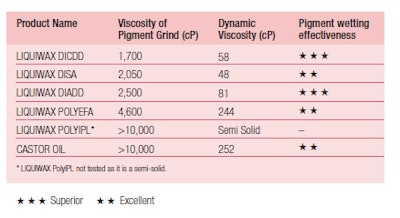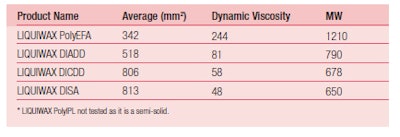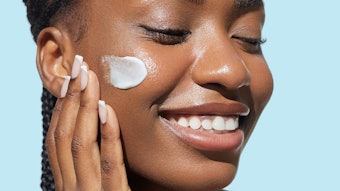
Color cosmetic claims are becoming increasingly sophisticated and interconnected to trends seen in the skin care category. The need for multifunctional products that deliver a myriad of perceivable benefits has been an expectation of consumers for some time. Claims on the market currently range from waterproof to anti-aging, yet within these additional benefits, color cosmetics still need to provide the basic function of delivering colorant (pigment) to the skin (or lashes). Ingredients that deliver great color, as well as offer additional benefits in the formulation are key to providing multifunctional success.
The Liquiwax® range of cosmetic esters (see Table 1) combines the emolliency of traditional esters with skin conditioning functionality to address the consumer need for skin care effects in color cosmetics. The esters’ high molecular weight, in conjunction with their characteristic shape, limits penetration through the stratum corneum, and this surface deposition imparts a consumer perceivable softening and lubrication effect, as well as enhanced barrier function for excellent moisture retention.
The Liquiwax range can serve a variety of functions in a multitude of applications. Most notably, they can be used in color cosmetics to adjust after feel, viscosity control and pigment dispersion.
Pigment Wetting
Pigments need to be properly wetted to be effectively incorporated into a color cosmetic formulation. Liquiwax esters offer excellent pigment wetting properties. To evaluate the comparative pigment wetting abilities of the Liquiwax range, grinds were created, with a 35:65 ratio of an organic pigment (D&C Red No. 7 Calcium Lake) to ester, using castor oil as a standard. The lower the viscosity of the pigment grind, the better the product's ability to spread over the pigments and to displace air around them, as shown in Table 2. In evaluations, Liquiwax DICDD (INCI: Dioctyldodecyl Dodecanedioate) proved to be the best pigment wetting agent since it creates the lowest viscosity pigment grind, despite having a higher dynamic viscosity than Liquiwax DISA (INCI: Diisostearyl Adipate).
As previously mentioned, with the lines of color cosmetics and skin care becoming blurred and products such as BB creams gaining in popularity, the use of wax-compatible esters with exceptional pigment dispersing benefits, as well as tailored sensorial properties, is an efficient and effective approach.
Skin Spreadability
The ability of an emollient to spread well over the skin is crucial in certain color cosmetic formulations, such as liquid foundation. The Liquiwax range offers a variety of skin spreading abilities to address the needs of various color cosmetic formulations, as sometimes good spreading is desired and sometimes makeup should stay put.
It is generally known that there is a direct relation between skin migration value and the dynamic viscosity of a liquid. The lower the dynamic viscosity, the higher the skin migration value will be. For the Liquiwax range, there is also a direct relation between the molecular weight and skin migration. The lower the molecular weight, the higher the skin migration value, as shown in Table 3. All of the Liquiwax products exhibit medium spreading, except for Liquiwax PolyEFA (INCI: Octododecyl/PPG-3 Myristyl Ether Dimer Dilinoleate), which has low-medium spreading.
Higher skin spreading (or migration) is beneficial in other types of applications, such as self-tanners, as well as sunscreens where an even application is essential. For formulations offering sun care claims, Liquiwax DICDD would be recommended due to its skin spreading capability.
On the lower end of the skin spreading (migration) range is Liquiwax PolyEFA, which offers a lower skin spreading effect. This combined with its omega-6 linoleic acid chemistry, makes it ideal for lip balms and body butter applications.
Multifunctional Capabilities
The Liquiwax range offers truly multifunctional benefits in color cosmetics applications, allowing formulators to incorporate the trends from skin care into their products. The benefits of the range extend beyond pigment wetting and skin spreading and allow formulators to: provide consumer perceivable softening to the skin; enhance barrier function; improve moisture retention; contribute gloss; and offer great wax compatibility.
The Liquiwax range can be formulated into more than color cosmetics, showing great performance in creams, lotions, body butters, lip balms, self tanners and sun care.
To learn more about the Liquiwax range, visit www.croda.com/na/pc.
Disclaimer:
The above paid-for content was produced by and posted on behalf of the Sponsor. Content provided is generated solely by the Sponsor or its affiliates, and it is the Sponsor’s responsibility for the accuracy, completeness and validity of all information included. Cosmetics & Toiletries takes steps to ensure that you will not confuse sponsored content with content produced by Cosmetics & Toiletries and governed by its editorial policy.













